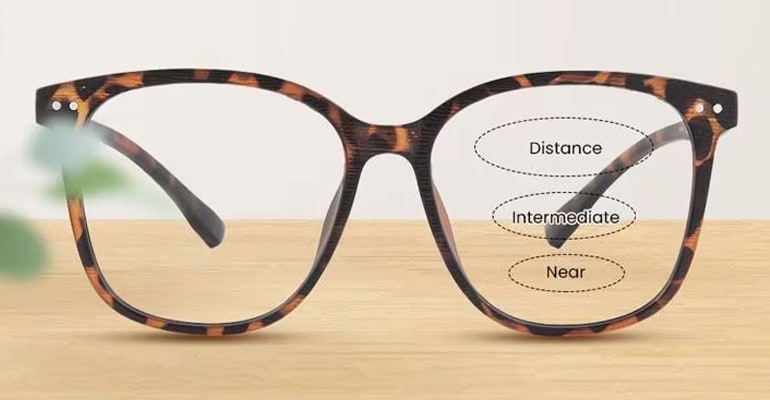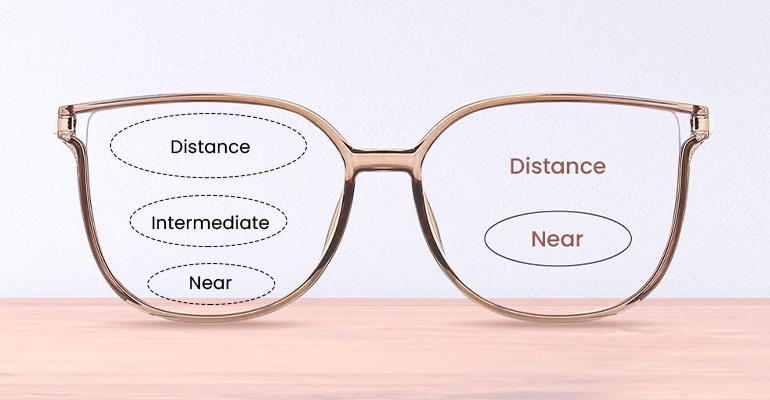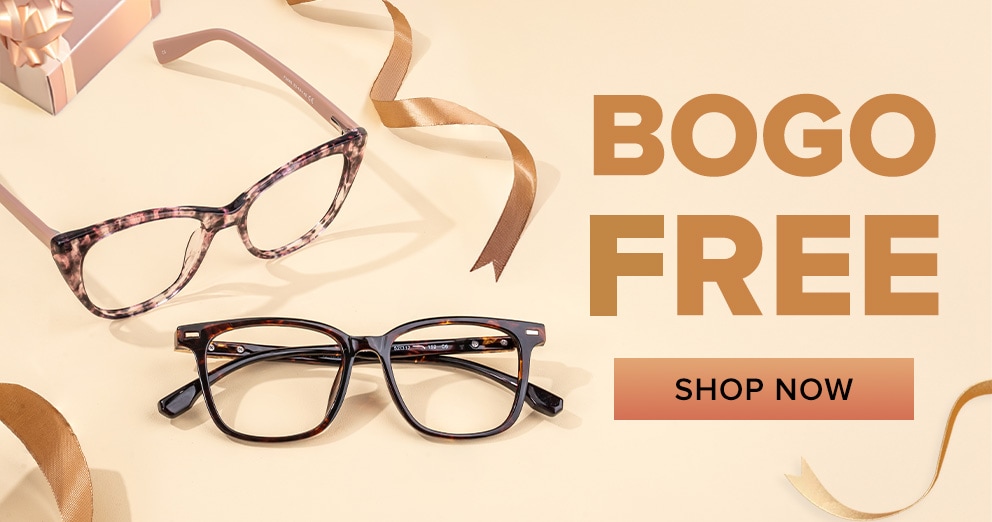What are Bifocals? Comprehensive Guide with Purpose and Function
May 31, 2024

If you are getting older and struggling to read things up close, constantly having to take your glasses on and off can be a struggle, which is where bifocals come in.
Bifocals provide optical correction for two distances, this can be reading and long distance or other vision needs.
We've got everything you need to know about bifocals in our guide below, from what are Bifocals, their history, types of bifocals, alternatives, and how to get started wearing bifocals.
What Are Bifocals & How Do They Work?
If you are wondering, what are Bifocals? They are also known as multifocal lenses and have two separate optical powers in them.
Essentially, they are one lens stuck onto another, the larger lens up top is made for long distances while the smaller one at the bottom also known as the segment is for reading.
These glasses work since when you look long distance you look straight through the distance part of the lens, and when you look down through the near vision part you can see objects up to 18 inches away.
Vision Problems That Require Bifocal Lenses
So, what are bifocal glasses used for? Well, bifocals are commonly prescribed for people over 40 when their vision starts to deteriorate, this is a common vision condition known as Presbyopia.
However, there can be other causes too where bifocal lenses can come in use.
-
Presbyopia and Aging Eyes - Presbyopia is a condition that occurs naturally as your eyes age. The change comes from the loss of flexibility in the eye's lens, which makes it harder to focus on close objects.
-
Myopia and Hyperopia - Myopia is when your eyeball is slightly elongated from the front to the back. This forces light to the front of your retina, the image on the retina then means close-up items are sharp and far items are blurred. For hyperopia, it’s the opposite, meaning your eyeballs are shorter and the cornea is flatter. The image behind the retina means that images far away are clearer, while close-ups are more blurry.
-
Astigmatism and Other Eye Conditions - Astigmatism means your vision is blurry at all lengths since your eyes are an irregular shape.
What Are Bifocal Lenses History?
Bifocals were invented in 1784 by the infamous Benjamin Franklin. He was having vision problems seeing far and close and needed a solution rather than wearing different eyeglasses all the time so he could see properly.
He made a pair of makeshift bifocal glasses by splitting each lens in half to create double spectacles.
Since the 1800s, bifocals started to change into more practical eyeglasses around the 19th and 20th centuries, known as progressive lenses which took the distracting line away in the middle of them.
Types Of Bifocal Lenses
Bifocal lenses are now available in a few different types.
D Segment & Round Segment
D segment bifocal lenses have a recognizable D shape at the bottom of the lens close to the nose. These lenses are often the most popular to wear since they give a natural look.
Round segment bifocals are less popular and were created to make reading easier since the lens is closer to the nose.
Executive and Ribbon Segment
Executive bifocals are essentially line bifocals and have a clear line between the top half and bottom half of the lens. The lens tends to be most popular with people who do a lot of reading or desk work since it's a 50/50 split.
Ribbon segment bifocals have a small rectangular area that allows close-up viewing when you are reading and on your phone.
Progressive and Trifocal Lenses
Progressive bifocal lenses have no line in between them and have a much wider range of power than bifocals, they are more popular since they have no line. Trifocal lenses have three powers in them; distance, intermediate, and near vision, and have two segmenting lines.
Trifocal lenses aren’t commonly prescribed because it's rare people need three prescriptions, plus, there are lots of segmenting lines.
Modern Alternatives To Bifocals
Not everyone is keen on Bifocals due to the lines, some alternatives are progressive lenses and multifocal contact lenses.
-
Progressive glasses - These are nowadays a popular choice over bifocals. This is because they allow you to correct your far vision and close vision needs without visible lines in between each segment.
-
Multifocal contact lenses - These are excellent alternatives for people who don’t want to wear glasses. They are a good choice for presbyopia to correct age-related vision problems and tend to have three prescriptions for close, intermediate, and far combined into one.

What Are Progressive Lenses?
Progressive lenses are the same as progressive glasses. They allow you to correct both far vision, close and intermediate without noticeable lines in between each segment of the lens. You can get progressive lenses in both contact lens versions and glasses.
What are Some Benefits of Progressive Lenses over Bifocals?
Progressive lenses are essentially the more modern version of bifocals and have several benefits over progressive lenses.
-
You need just a single pair of glasses - A single pair of progressive glasses is much more convenient than multiple pairs of bifocal glasses.
-
Gives a more modern look - Since bifocals with lines are often seen in the older generation, progressive lenses look more modern and youthful instead.
-
No distracting bifocal line - Without the multifocal line in progressive lenses, your eyesight gradually shifts, making progressive lenses feel more natural than bifocals.
Why Should You Choose Our Premium Progressive Lenses?
At GlassesShop we have a wide range of premium progressive glasses for people who want a modern eyeglass.
Here are some of the top reasons you should choose our progressive lenses.
-
Stylish frames - We offer progressive lenses in a huge variety of frames, from cat eyes to rectangular and oval, no matter the type of frame you want, we have it.
-
Affordable prices - Compared to other eyeglass shops, we have running discounts on our eyeglasses and very competitive pricing without compromising on the quality.
-
Clear Zone for Viewing - Our progressive lenses offer clarity and no obstruction when viewing through our lenses, unlike bifocals.
-
Blue Light Blocking Filters - You can pair many functions with your eyeglasses like blue light blocking. Blue light blocking protects your eyes from the blue light of devices, while Blue Light Pro has day and night protection.
-
Ultra-Lightweight Lenses - All our progressive lenses are lightweight and convenient to wear for extended periods thanks to their lightweight framing.
-
Specialized Coatings for Better Vision - The specialized coatings on our progressive lenses make them anti-scratch and clear.
-
Customizable - No matter whether you want plain black and white, tortoise, or floral, at GlassesShop we have a great variety of colors to choose from to customize your new progressive lenses with.
-
Virtual try-on - We offer a virtual try-on service on our website which allows you to try on your glasses before you buy so you can see if they suit your face shape.
How To Get Started With Bifocal Lenses
If you’ve decided to buy a pair of bifocal lenses, then you’ll need to consider a few factors, like the materials and frame, to make sure they are right for you.
Choosing Your Bifocal Glasses
Before deciding you want bifocal lenses, it’s important to get a comprehensive eye exam done by your optician first. After you receive your updated prescription, you can then choose according to your optician's recommendations or bifocals matching your vision needs.
Design And Features Of Bifocals
When picking your bifocals, consider the lens materials and coatings.
At GlassesShop we offer most commonly glass lenses but have a variety of different coatings. All our eyeglasses come with an anti-scratch coating, but we also offer blue light protection and photochromic coatings which help with light in dull conditions and reduce glare in bright conditions.
Also, think about the frame styles and fit, you want to ensure your glasses are comfortable and fit your face. You may want upward angular frames, rectangle frames, or circular frames.
Specialized Bifocals
You can also choose from specialized bifocals such as occupational bifocals, also known as computer glasses, also the bifocal reading glasses non prescription. These are designed to fit so that you can get computer screen vision through the top part of the lens and close reading material in the bifocal part.

What Are Some Tips For Getting Used To Bifocals?
When you first start wearing bifocals, there will likely be an adjustment period while your eyes get used to them.
We recommend following these tips so you can get used to your glasses.
-
Be patient - It’s common for it to take a few weeks to adjust to your new bifocals, patience is key in this case, so stick at it.
-
Wear them as much as you can - Wearing your bifocals as much as you can will help you get used to the correct head and eye positioning.
-
Go for regular eye exams - Booking regular optician appointments will help you maintain your clear vision and keep on top of any prescription changes.
The Role Of Bifocal Glasses In Eye Care
Bifocal glasses are extremely important in various eye care applications. For pediatric eye care, these glasses can help children who have reduced focusing abilities, whether this is a blurry vision when quickly looking at close-up subjects or vision fatigue.
These can also be called learning lenses to support children's vision when focusing for long periods.
Bifocal glasses also have a big role in helping people with vision rehabilitation for people with Stargardt's disease or other eye impairments.
Cost & Affordability Of Bifocals
One big factor to consider when shopping for bifocals is the cost and affordability. Bifocals will cost you a little more than traditional lenses due to the multi-prescription in the lenses. Progressive lenses will be more expensive than bifocals, as they are more modern and have no lines.
Order Your Bifocal & Progressive Lenses With GlassesShop
If you are tired of switching out your glasses and want convenience, then do yourself a favor and get a pair of bifocals or progressive lenses.
At GlassesShop we sell both bifocals and progressive lenses in lots of gorgeous designs and offer special coatings according to your lifestyle and vision needs.
So, let's get your vision sorted today and order your new bifocal glasses to give you back the vision freedom you desire.
